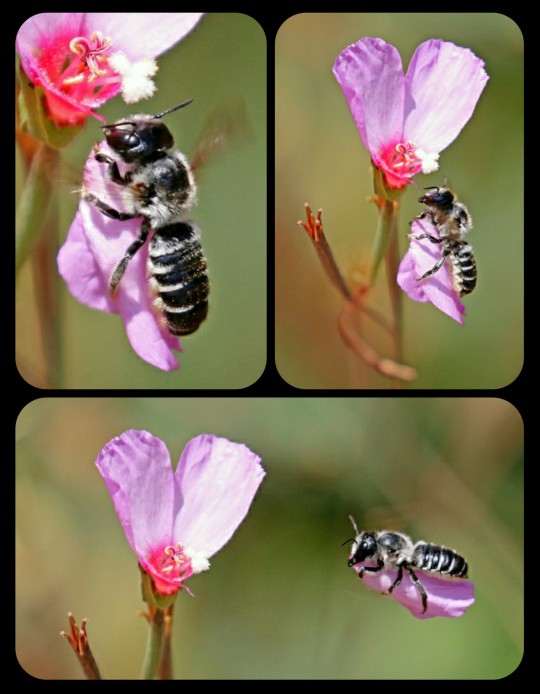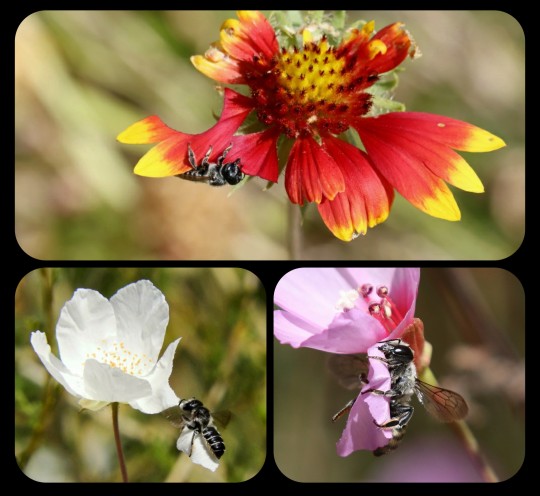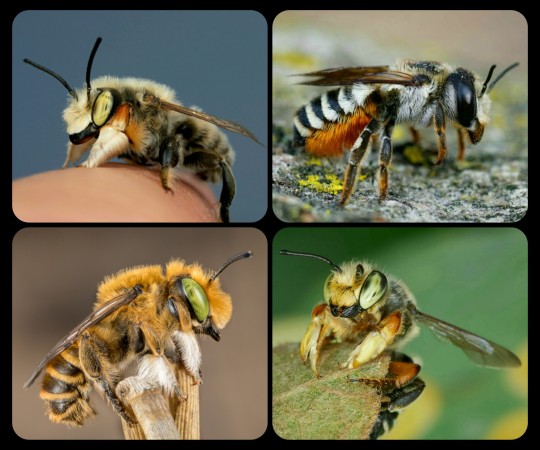#Florida leafcutter bees
Text
Black Bees and Yellow Sumac: A Wonderful Fall Combination
Black Bees and Yellow Sumac:A Wonderful Fall Combination shows readers some photos of a carpenter mimic leafcutter bee as it feeds on winged sumac flowers. It goes on the explain how the bees were named and discusses the author/artist’s experiences.
Black Beauty
The winged sumac flowers have come and gone, but they’re not forgotten. Back in September, when they were blooming like crazy, the pollinators were flocking to them. It definitely made for a couple of fun photo sessions out in the woods and also some great color combinations. There’s just something about hundreds of little yellow flowers that looks really stunning with black or…

View On WordPress
#bee photographs#bee photography#bees#black bees#black insects#black leafcutter bees#carpenter mimic leafcutter bees#fall bees#fall insects#Florida bees#Florida insects#Florida leafcutter bees#insect photographs#insect photography#insects#leafcutter bee photographs#leafcutter bees#macro photographs#macro photography#photography
1 note
·
View note
Text
Leafcutter Bees: these bees snip off bits of foliage and/or flower petals and then weave the pieces together to build their nests

The nests are built and used only by the female leafcutter bees (family Megachilidae). Unlike honey bees, leafcutters do not form colonies or live together in hives, meaning that each nest belongs to a single, solitary bee.

The females use their mandibles to cut out pieces of foliage, carefully snipping off rounded segments and then carrying them back to an existing cavity/burrow (which may be located in a plant stem, a piece of wood, the side of a tree, etc.), where the pieces are used to construct a series of brood cells along the inner walls of the cavity.
Most leafcutter bees build their nests out of leaves, but there are some species that are more accurately described as "petalcutters," because they use flower petals instead.

The Silver-Tailed Petalcutter Bee (M. montivaga): this species uses flower petals to build its nest; it is one of the few Megachilid bees to do so
The leaves and/or flower petals are then folded together along the inner walls of the chamber, forming a long, cigar-shaped nest that contains multiple brood cells.

As this article explains:
Leafcutter bees may nest in many different spaces, such as existing holes in timber or masonry, hollow stems, gaps in door/window frames, old folded towels left outside, rock walls and outdoor furniture.
Each female builds her own nest. The cut leaves are used to make a tube as a nest for the eggs or to line an existing hole with it. The leaves are cut in various shapes, round and elongated, to suit the construction of the cell for the eggs. The cell is then stocked with a mixture of nectar and pollen in which the leafcutter bee lays her eggs.
There are multiple brood cells built into the internal structure of the nest, but they are all separate from one another. Each cell contains a single egg, along with just enough pollen and nectar to sustain the larva until it reaches maturity.
When the eggs hatch, tiny larvae eat the provisions and, when fully grown, they spin silky cocoons and then develop into pupae, finally emerging as adult bees.
Leafcutter bees come in a wide variety of colors, shapes, and sizes. These are just a few other examples:

Top Row (left-to-right): Megachile latimanus and Megachile octosignata; Bottom Row: Megachiloides sp. and Megachile poeyi
Sources & More Info:
University of Colorado's Museum of Natural History: Leafcutting Bee
Florida Wildflower Foundation: Getting to Know your Native Pollinators - Leafcutter Bees
University of Nebraska: Facts about the Leafcutter Bee
Land for Wildlife (Southeast Queensland): Leafcutter Bees
What's that Bug?: Leafcutter Bee Life Cycle - a Fascinating Journey Revealed
Entomology Today: Beyond the Honey Bee - How Pesticides Affect Solitary, Cavity-Nesting Bees
#entomology#insects#nature#hymenoptera#arthropods#megachile#megachilidae#leafcutter bees#petalcutter bees#animals#biology#flowers#cute bugs#bees#solitary bees#gardening#plants#cute animals#bugs that like to pick flowers#to decorate their homes
38 notes
·
View notes
Text

Excerpt from this press release from the Center for Biological Diversity:
The Environmental Protection Agency announced Monday that it has approved emergency use of a bee-killing neonicotinoid pesticide on up to 75,000 acres of Florida citrus crops, including oranges, tangerines, grapefruits, lemons and limes.
This marks the 10th year that the EPA has granted a so-called “emergency” exemption of clothianidin for use on bee-attractive citrus trees in Florida to target the Asian citrus psyllid, the vector for citrus greening disease.
“This is truly a race to the bottom when it comes to the ever-more toxic chemical soup being applied to these fields,” said Nathan Donley, environmental health science director at the Center for Biological Diversity. “When the EPA grants so-called emergency approval year after year to a pesticide that’s never undergone a full safety review there’s something fundamentally wrong about this approach.”
There are currently 16 different insecticides approved to combat this insect in Florida, including three other neonics: imidacloprid, thiamethoxam and sulfoxaflor, according to the University of Florida.
Imperiled pollinators that will likely be harmed by today’s approval include the American bumblebee, the southern plains bumblebee and the leafcutter bee.
The EPA has routinely circumvented the normal pesticide-approval process by allowing emergency exemptions for predictable and chronic situations that occur over many consecutive years. Emergency exemptions allow the use of pesticides that are either not approved or are approved for some uses but prohibited for certain other uses.
In 2019 the EPA’s Office of the Inspector General released a report finding that the agency’s practice of routinely granting emergency approval for pesticides across millions of acres does not effectively measure risks to human health or the environment.
5 notes
·
View notes
Text
"i love leafcutter bees and when people say ohh whats making holes in my leaves what should i do about it i say you should go out and have a beer!"
- approximate quote from craig huegel from the keynote hes doing for the florida native plant society right now
7 notes
·
View notes
Photo

Megachile lanata - Globetrotting tropical leafcutter, decked in orange. If I recall the story right this is originally a bee of the Indian subcontinent. Why it and not other (but some!) leafcutters now roam tropical islands around the world is an interesting mystery (at least to me). This specimen is from GTMO (Guantanamo Military Base) in Cuba, if you go to Hawaii or Florida you will find this rather magnificent bee there too. Records dating back in some instances to the 1700s prior to when most of the bees of North America were described!
#bee#bees#megachile#tropical#caribbean#freight#shipping#sailing#islandhopping#escapee#usgs#orange#leafcutter#invasive
79 notes
·
View notes
Photo

A busy native Leafcutter bee visiting Spanish needle blossoms on a sunny morning at Frenchman's Forest Natural Area, Palm Beach, Florida, USA.
photograph by Bob Peterson | Flickr CC
38 notes
·
View notes
Video
Ever seen a “bee-rito”? Now you have. 🐝🌯 Leafcutter bees are a large family of solitary pollinators, meaning they don’t produce colonies like our social honeybees. As their name implies, leafcutters carve out pieces of leaves to construct their nests, favoring hollowed out, tube-shaped cavities as nesting sites. Many species of leafcutters are found around the world, including North America. Florida alone is home to more than 60 species of leafcutter bees. This hatchling, captured by @emiliagoxd, is one of several species found in the UK. taking inspiration from 4.54 billions years of earth nature @natureinspirations_ #natureinspirations #instaanimal #conservation #wildliferehab #wildlifephotography #global4nature #wildlife_inspired #animalsofinstagram #wildlifeconservation #wildlifeartist #wildlifeofuk #animals #africa #animalpolis #wildlifeowners #wildlife_perfection #animalsaddict #wildlifeonearth #igswildlife #wildlife #wildlifetrust #wildlifephotos #wildlifeprotection africa #majestic_wildlife_ #wildliferefuge #wildlife_supreme #naturephotography #sharingiscaring #quokka #groundhog https://www.instagram.com/p/B70MJCXAjX7/?igshid=194xyh8k8f4mk
#natureinspirations#instaanimal#conservation#wildliferehab#wildlifephotography#global4nature#wildlife_inspired#animalsofinstagram#wildlifeconservation#wildlifeartist#wildlifeofuk#animals#africa#animalpolis#wildlifeowners#wildlife_perfection#animalsaddict#wildlifeonearth#igswildlife#wildlife#wildlifetrust#wildlifephotos#wildlifeprotection#majestic_wildlife_#wildliferefuge#wildlife_supreme#naturephotography#sharingiscaring#quokka#groundhog
0 notes
Text
The Work of Bees Last Fall Leads to Beautiful Flowers Now
The Work of Bees Last Fall Leads to Beautiful Flowers Now discusses the role of last year pollinators in helping to bring us crops and wildflowers this year. It shows readers one of the many types of bees found in Florida.
Eager Bee
Last fall before the first frost, the area was crazy alive with bees. There were many different types of them stocking up on nectar and pollen to get them or their hive or nest through the winter. There were lots of flowers, especially blackjacks, that time of year. This was one of many bees that were buzzing around from flower to flower not only eating, but also carrying pollen…

View On WordPress
#beautiful bees#beautiful insects#bee photographs#bee photography#bees#black bees#black insects#carpenter-mimic leaf-cutter bees#Florida bees#Florida insects#Florida pollinators#insect photographs#insect photography#insects#large bees#leafcutter bees#photography#pollinators#solitary bees
2 notes
·
View notes
Text
Fall Pollinators are Coming Out for the Fall Wildflowers
Just a Little Black Bee
The winged sumac (Rhus copallinum), which is definitely a fall wildflower, albeit an early one, was highly attractive to many pollinators while it was in full bloom. Along with the usual summer crowd, I’m beginning to see some of the fall group like this carpenter mimic leafcutter bee (Megachile xylocopoides). Although they can be found in small numbers in the summer, I…

View On WordPress
#bee photographs#bee photography#bees#black bees#black insects#carpenter mimic leafcutter bees#fall bees#fall insects#fall pollinators#Florida bees#Florida insects#Florida pollinators#insect photographs#insect photography#insects#leafcutter bee photographs#leafcutter bees#macro photographs#photography#pollinator photographs
0 notes
Text
The Carpenter-mimic Leafcutter Bees are Special Pollinators
The Carpenter-mimic Leafcutter Bees are Special Pollinators shows readers these large, solitary bees. It goes on to present several things that make these bees interesting and unique.
Food Line
We are nearing the end of fall, and all our wildlife is taking advantage of getting as much food as possible before cooler weather arrives. Fall wildflowers and grasses are fading and turning to seed and even the insect world is stocking up on food wherever they can. When I came home from work one afternoon last week what was left of the blackjack (Bidens pilosa) flowers were literally…

View On WordPress
#aster pollinators#bee photographs#bee photography#bees#black bees#carpenter-mimic leafcutter bees#Florida bees#Florida insects#insect photographs#insects#large bees#leafcutter bees#noisy bees#photography#pollinators#solitary bees#specialist bees#specialist pollinators
0 notes